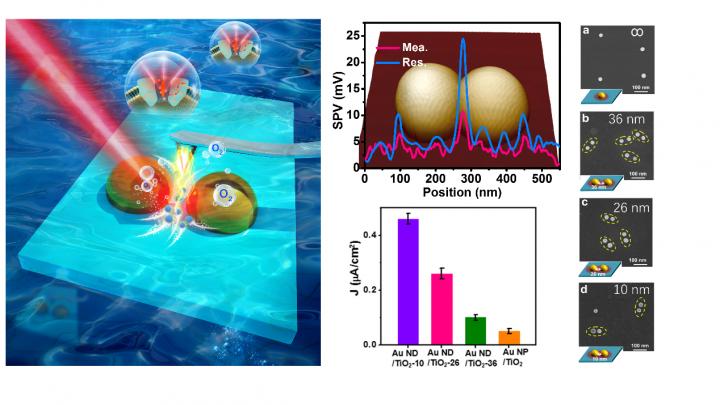Observation charge accumulation at nanocavity on plasmonic photocatalyst

Schematic illustration of au dimers/TIO2 to simulate the photosystem II and plasmonic charge accumulation at nanocavity for water oxidation.
Credit: ©Science China Press
Strong interaction between plasmonic nanoparticles and free-space light induced the evanescently confined modes on the nanoparticle surfaces, which holds great promise in plasmonic nanophotonic technologies. Plasmonic nanoparticle with the capability of generating energetic charges makes it being widely exploited in the field of photocatalysis, providing a new paradigm for conversion renewable sunlight to useful fuels and high-value chemicals.
Plasmon metal nanoparticles/semiconductors with Schottky barrier at interface are well-received photocatalysts that can achieve charge spatial separation to prolong the lifetime of separating charge for matching the timescale of surface chemical reactions. The key question in the plasmonic photocatalysis is how plasmonic charges can be effectively separated to improve charge density at catalytic sites, which is critical to multi-hole/electron-driven redox reactions, such as water oxidation.
In natural photosynthesis, hundreds of functional pigments are distributed surrounding a reaction center of photosystem II to continuously supply photogenerated charges by increasing the light absorption flux. However, due to the lack of microscopic details of charge accumulation sites in artificial photosynthesis, there is less report for mimicking natural photosynthesis to extract sufficient hot holes in plasmonic photocatalysts for efficient oxygen evolution.
In a new research article published in the Beijing-based National Science Review, inspired by natural photosynthesis, Can Li and Fengtao Fan research group from Dalian Institute of Chemical Physics, Chinese Academy of Sciences, present an elegant approach to simultaneously address the critical problems of light harvesting and charge density at catalytic sites of plasmonic photocatalyst. The group constructed Au nanoparticle dimers on TiO2 as optical antenna, and found charge accumulation at nanocavity of Au dimers/TiO2 photocatalyst mediated by surface plasmon resonance coupling. Combining experimentally measured surface photovoltage with theoretical calculations, the local density of hot hole was demonstrated to be related to the square of local near-field intensity. Using four-electron involved water oxidation reaction as a probe reaction, the performance of Au dimer/TiO2 photoanode can be improved by one order of magnitude compared to Au NPs/TiO2 photoanode.
The current work presents a previously unrecognized effect on charge accumulation at catalytic sites of plasmonic photocatalysts. Furthermore, it should encourage others to explore the significance of plasmonic hot spot to generate more charges – not only for photodetections, but also for photocatalysis associated with multiple charges transfer processes.
###
This research received funding from the National Natural Science Foundation of China, the Chinese Academy of Sciences Interdisciplinary Innovation Team, Dalian Institute of Chemical Physics Innovation Foundation, and the Strategic Priority Research Program and Equipment Development Project of the Chinese Academy of Sciences.
See the article:
Yuying Gao, Feng Cheng, Weina Fang, Xiaoguo Liu, Shengyang Wang, Wei Nie, Ruotian Chen, Sheng Ye, Jian Zhu, Hongyu An, Chunhai Fan, Fengtao Fan, and Can Li
Probing of coupling effect induced plasmonic charge accumulation for water oxidation
Natl Sci Rev
https:/
The National Science Review is the first comprehensive scholarly journal released in English in China that is aimed at linking the country’s rapidly advancing community of scientists with the global frontiers of science and technology. The journal also aims to shine a worldwide spotlight on scientific research advances across China.
Media Contact
All latest news from the category: Interdisciplinary Research
News and developments from the field of interdisciplinary research.
Among other topics, you can find stimulating reports and articles related to microsystems, emotions research, futures research and stratospheric research.
Newest articles

Bringing bio-inspired robots to life
Nebraska researcher Eric Markvicka gets NSF CAREER Award to pursue manufacture of novel materials for soft robotics and stretchable electronics. Engineers are increasingly eager to develop robots that mimic the…

Bella moths use poison to attract mates
Scientists are closer to finding out how. Pyrrolizidine alkaloids are as bitter and toxic as they are hard to pronounce. They’re produced by several different types of plants and are…

AI tool creates ‘synthetic’ images of cells
…for enhanced microscopy analysis. Observing individual cells through microscopes can reveal a range of important cell biological phenomena that frequently play a role in human diseases, but the process of…





















